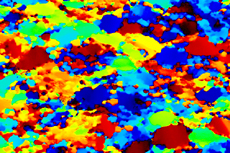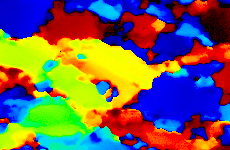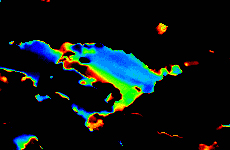3.1
VISUALIZING ORIENTATIONS
top / contents / section3/ pages -- 3.1 -- 3.2 -- 3.3 -- 3.4 -- 3.5 -- 3.6 -- 3.7 -- 3.8 -- 3.9
Colour-coding the azimuth image





The azimuth image (see section 2.5) is a monochrome image whose grey values correspond to the azimuths of the c-axes at each pixel (see sign convention, section 1). Using NIH Image (or Scion Image) and the Lazy LUT macro ("spectrum black-blue-red-black", see appendix 2), the azimuth image can be colour-coded in terms of the visible spectrum of light: blue (short wavelengths) for low, red (long wavelengths) for high values.
Using a 1-D Look-up table (LUT), the grey values can be colour-coded. To achieve an interpretable colour-coding, one may want to design LUTs that are not provided by NIH Image. Here we use a 1-D spectrum LUT which grades into black at the lower and upper end. If the LUT covers the entire range between 0° and 180°, the azimuths in the N-S direction (0° or 180°) are rendered black, in NE-SW direction (45°) blue, in E-W direction (90°) green, and in NW-SE direction (135°) red. In order to highlight small, local azimuthal differences, the LUT can be compressed, in the example shown, the spectrum is compressed between 120° and 150°, green indicating the central value (135°).
The 1-D LUT can be represented as stereographic colour look-up table (CLUT). Note that this CLUT is not the same as the 2-D spectrum CLUT for c-axis orientation images (see CLUT library), since there is no variation of colour saturation as a function of inclination (i.e. from the center of the stereographic projection of the CLUT to the periphery).
Left, from top to bottom:
- Colour-coded azimuth image of experimentally deformed Black Hills quartzite
- Detail of above using same LUT
- Same detail using compressed LUT